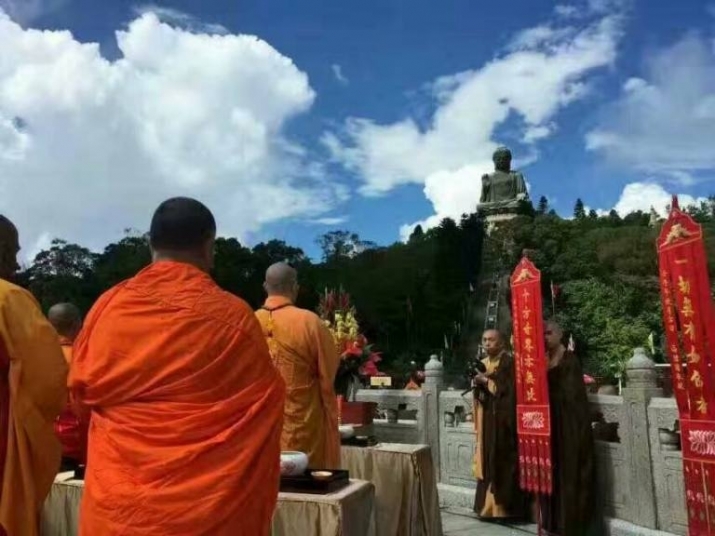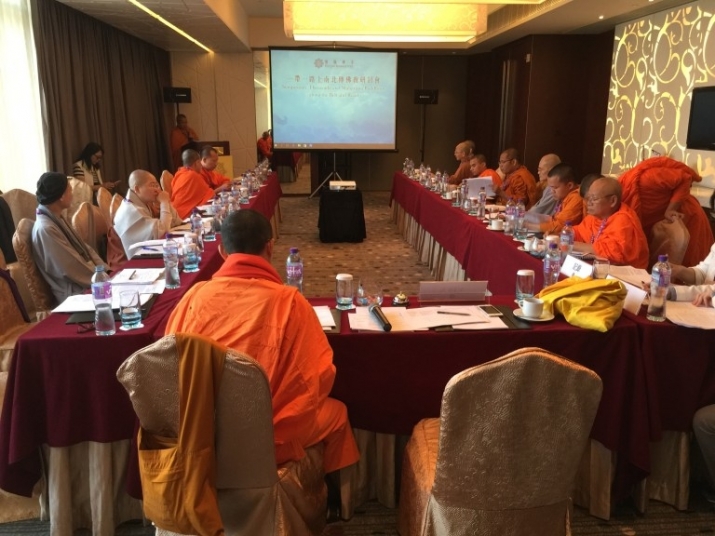NEWS
Hong Kong’s Po Lin Monastery Hosts Belt and Road Symposium
 Monks at Po Lin Monastery mark the anniversary of the Hong Kong handover on 29 June. Image courtesy of Hugo San
Monks at Po Lin Monastery mark the anniversary of the Hong Kong handover on 29 June. Image courtesy of Hugo SanPo Lin Monastery, one of Hong Kong’s most important Buddhist temples and organizations, hosted a symposium on China’s Belt and Road Initiative from 29–30 June. The symposium coincided with president Xi Jinping’s visit to Hong Kong for the 20th anniversary of the city’s handover from the United Kingdom to China. Po Lin separately marked the handover anniversary as well as the 25th anniversary of its “Big Buddha” statue, a popular tourist attraction on Hong Kong's Lantau Island.
Guests at the officiating ceremony on 29 June included Ven. Jingyin, the abbot of Po Lin Monastery and director of the Centre of Buddhist Studies at Chu Hai College, and Ven. Xuecheng, president of the Buddhist Association of China and abbot of numerous monasteries in mainland China. Many other senior Buddhist figures from Greater China, both lay and monastic, also attended. The second and final day of the conference concluded with a visit to Chu Hai College, where guests were shown around the campus.
The conference, with separate sessions held at Dorsett Tsuen Wan and L’hotel Nina Et Convention Centre, centered on how the Belt and Road Initiative affected, and would in turn be influenced by, Mahayana and Theravada Buddhists. Its themes emphasized the synergy between the 21st Century Maritime Silk Route Economic Belt initiative and Buddhist institutions.
Accordingly, the event’s guests were drawn from not only the northern traditions, mostly Chinese Buddhism, but also from a large pool of predominantly Theravada nations, especially Thailand. Po Lin Monastery has established a working relationship with Thailand’s oldest and perhaps most influential Buddhist tertiary institute, Mahachulalongkornrajavidyalaya University (MCU), with an eye to developing a Buddhist Studies curriculum for monastics in tandem with MCU’s advice and accreditation. Monastic and academic guests from other Southeast Asian countries, including Cambodia, Sri Lanka, and Vietnam, were also present.
 A symposium session at L'hotel Nina Et Convention Centre on 30 June. Photo by Buddhistdoor Global
A symposium session at L'hotel Nina Et Convention Centre on 30 June. Photo by Buddhistdoor GlobalSymposium topics included the history and current situations of countries along the Belt and Road, the Internet and Buddhist education, and opportunities and challenges facing Belt-and-Road countries, from promoting Buddhist-themed tourism to achieving gender parity within the various Buddhist schools. A crucial focus of the conference was what Theravada and Mahayana Buddhism could learn from each other, and to explore how Buddhism is taught in the different societies. This theme invoked the long history of cultural exchange between East, Southeast, and South Asia.
There were also speeches and presentations on Dunhuang art and Buddhist philosophy. Karma Lekshe Tsomo, fresh from organizing the 15th Sakyadhita conference at the University of Hong Kong, also presented a paper on the spirituality of ethnic Chinese communities in Indonesia.
With Southeast Asian relations growing in importance to China, and Hong Kong’s potential as a financial and business conduit along the 21st Century Maritime Silk Route Economic Belt in little doubt, the region can be sure to see many more dialogues like this recent symposium in future.
Related blogs from Buddhistdoor Global
Of Statecraft and Sangha: Po Lin Monastery and the Silk Road














